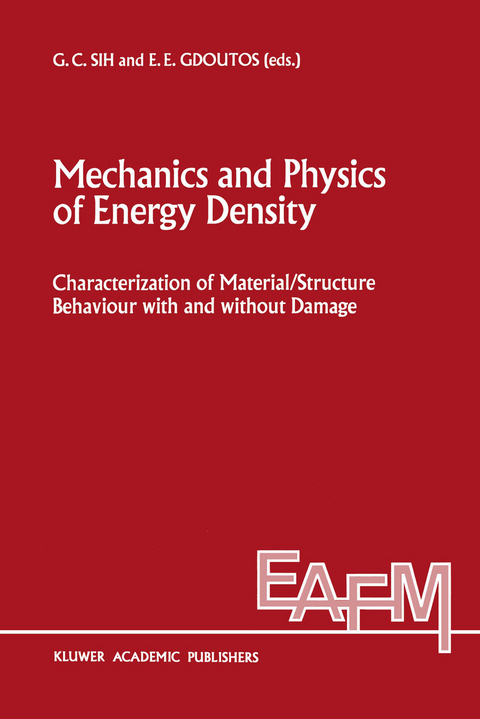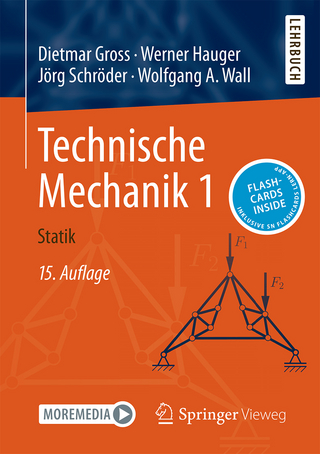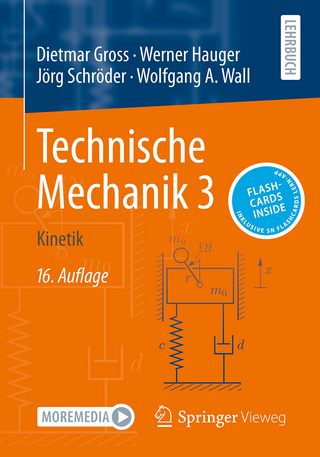
Mechanics and Physics of Energy Density
Kluwer Academic Publishers (Verlag)
9780792306047 (ISBN)
The material presented falls within the areas of: Fundamentals of Strain Energy Density, Damage Analysis on Strain Energy Density, Strain Energy Density as Failure Criterion, Applications, and Composites.
1. Synchronization of thermal and mechanical disturbances in uniaxial specimens.- 1.1 Introductory remarks.- 1.2 System inhomogeneity and continuity.- 1.3 Simultaneity of displacement and temperature change.- 1.4 Isoenergy density theory.- 1.5 Axisymmetric deformation.- 1.6 Nonequilibrium response of cylindrical bar specimen in tension.- 1.7 Conclusions.- References.- 2. Thoughts on energy density, fracture and thermal emission.- 2.1 Introduction.- 2.2 The F-111 wing pivot fitting.- 2.3 Damage assessment of an F/A-18 stabilator.- 2.4 The finite element model.- 2.5 Thermoelastic evaluation of damage.- 2.6 Stress fields from temperature measurements.- 2.7 Conclusions.- References.- 3. Effects of fillers on fracture performance of thermoplastics: strain energy density criterion.- 3.1 Introduction.- 3.2 Experimental consideration.- 3.3 Fracture analysis.- 3.4 Strain energy density criterion.- 3.5 Conclusions.- References.- 4. Strain energy density criterion applied to characterize damage in metal alloys.- 4.1 Introduction.- 4.2 Strain energy density criterion.- 4.3 Thermal/mechanical interaction in solids.- 4.4 Damage characterization.- 4.5 Transition of micro- to macrodamage.- 4.6 Concluding remarks.- References.- 5. Local and global instability in fracture mechanics.- 5.1 Introduction.- 5.2 Strain energy density fracture criterion.- 5.3 Strain-hardening materials.- 5.4 Strain-softening materials.- 5.5 Size effects on strength and ductility.- References.- 6. A strain-rate dependent model for crack growth.- 6.1 Introduction.- 6.2 Description of the method.- 6.3 Specimen geometry and material properties.- 6.4 Stress analysis.- 6.5 Crack growth initiation.- 6.6 Concluding remarks.- References.- 7. Extrusion of metal bars through different shape die: damage evaluation by energy density theory.- 7.1 Introduction.- 7.2 Yielding/fracture initiation in plastic deformation.- 7.3 Nonlinear behavior of extruded metal.- 7.4 Analysis of failure initiation sites.- 7.5 Conclusions 135 References.- References.- 8. Failure of a plate containing a partially bonded rigid fiber inclusion.- 8.1 Introduction.- 8.2 A partially bonded rigid elliptical inclusion in an infinite plate.- 8.3 Local stress distribution and stress intensity factors.- 8.4 Failure initiation from the crack tip or the fiber end.- References.- 9. Crack growth in rate sensitive solids.- 9.1 Introductory remarks.- 9.2 Sih criterion.- 9.3 Linear viscoelastic solid.- 9.4 Crack growth in uniformly applied stress field.- 9.5 Conclusions.- References.- 10. Strain energy density criterion applied to mixed-mode cracking dominated by in-plane shear.- 10.1 Preliminary remarks.- 10.2 Sih’s strain energy density criterion.- 10.3 Mixed-mode cracking dominated by in-plane shear.- 10.4 Discussions.- References.- 11. Group-averaging methods for generating constitutive equations.- 11.1 Introduction.- 11.2 Generation of scalar-valued invariants.- 11.3 Generation of tensor-valued invariant functions.- 11.4 Applications.- References.- 12. A dislocation theory based on volume-to-surface ratio: fracture behavior of metals.- 12.1 Introduction.- 12.2 Super-dislocation model.- 12.3 Plastic zone size.- 12.4 Dislocation distribution in plastic zone.- 12.5 Crack in semi-infinite medium.- 12.6 Relation of volume/surface ratio to plate ligament.- 12.7 Specimens with different volume/surface ratio.- 12.8 Conclusions 191 References.- 13. The effect of microcracks on energy density.- 13.1 Introduction.- 13.2 Microcracked solid with given crack density.- 13.3 Microcrack nucleation.- References.- 14. Convex energyfunctions for two-sided solution bounds in elastomechanics.- 14.1 Introduction.- 14.2 General problem in elastostatics.- 14.3 Convexity of strain energy and Hubert space: elastic system.- 14.4 Global solution bounds.- 14.5 Local solution bounds.- 14.6 Concluding remarks.- References.
| Reihe/Serie | Engineering Applications of Fracture Mechanics ; 9 |
|---|---|
| Zusatzinfo | XXIV, 210 p. |
| Sprache | englisch |
| Maße | 156 x 234 mm |
| Themenwelt | Naturwissenschaften ► Physik / Astronomie ► Mechanik |
| Technik ► Bauwesen | |
| Technik ► Fahrzeugbau / Schiffbau | |
| Technik ► Maschinenbau | |
| ISBN-13 | 9780792306047 / 9780792306047 |
| Zustand | Neuware |
| Informationen gemäß Produktsicherheitsverordnung (GPSR) | |
| Haben Sie eine Frage zum Produkt? |
aus dem Bereich


